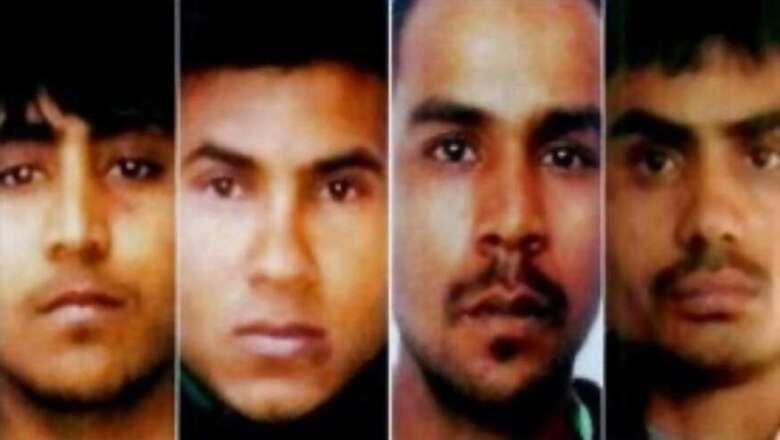
views
New Delhi: Days after it appeared justice had finally been delivered in the 2012 Nirbhaya fatal gang-rape case, when on January 7 a Delhi court set January 22 as the execution date for four perpetrators, the matter is hanging fire with the convicts filing a bunch of pleas seeking reprieve.
A 23-year-old physiotherapy student, later dubbed Nirbhaya by the media, was brutally gang-raped and thrown out of a moving bus in the national capital on December 16, 2012. She died a few days later at a Singapore hospital. The case sparked widespread revulsion, made international headlines, and led to strengthening of anti-sexual violence laws.
Six people were arrested. One of them, Ram Singh, died of possible suicide in police custody. Another, a juvenile, was convicted of rape and murder and given the maximum sentence of three years' imprisonment in a reform facility. On September 10, 2013, the remaining four were found guilty of rape and murder and three days later were sentenced to death by hanging. A process of appeals followed.
Fresh death warrants were issued on Friday, with February 1 the new date of execution. News18 explains the steps and directions in the Delhi Prison Rules 2018 on what is expected to happen next.
Confinement
According to the rules, a death row convict must be confined in a cell in a special yard, apart from other prisoners. The prisoner can remain in company of other prisoners, eat with them and have the right to facilities like education, legal aid, sports, labour, remission, etc, until all legal remedies are exhausted.
The cell must be examined and cleared off any kind of article by the deputy superintendent or by an officer appointed in that role, which may be used as a weapon of offence or as an instrument with which to commit suicide. The deputy superintendent will also maintain notes of psychological observation of the prisoner, to be checked daily by the superintendent and later sent to the inspector general to government.
The rules also state that prisoners facing a death sentence will be under 24-hour surveillance. The guard – one for each cell in this case as there are four convicts – must not be armed with a firearm, bayonet or any sharp object. The prisoner will not be hand cuffed unless he or she is violent.
Meeting relatives
The superintendent of the jail, the rules provide, may permit prisoners under death sentence to meet with relatives, friends or legal advisers twice a week or more. If the prisoner desires, a “religious priest or faith-based head” may also be summoned.
Role of the superintendent
With the approval of the superintendent, the prisoner may be allowed “religious books, religious pictures, rosary and essential religious emblems subject to security requirements, and newspapers and books”, the rules state.
He is also authorised to incur expenditure “for the purpose of giving reasonable solace to prisoner, for instance securing the presence of his near relative before his execution”.
The law also allows the superintendent to facilitate the desire of the prisoner to submit a mercy petition and assist him or her with legal aid. This shall happen “immediately on receipt of intimation of the confirmation by the High Court of a death sentence on a prisoner or of the dismissal by the Supreme Court of the appeal”. A seven-day period shall be given to submit such a petition, wherein the superintendent will forward it to the government and correspond with all parties.
The superintendent also has the authority to stop or postpone the execution if he or she thinks that the prisoner is not fit physically or mentally.
Day of the execution
Before the day of the hanging, an executive engineer of PWD will inspect the gallows every quarter. The same process shall be carried out before the date of the hanging. Inspection and testing of the rope must also be done in the presence of the superintendent.
The drop to be given to a prisoner, according to the person’s weight but between 1.830 and 2.440 metres, is also provided for in the Delhi Prison Rules 2018. The medical officer shall report this for all four prisoners four days before the date of hanging. The length of the rope will be adjusted accordingly.
“The Superintendent, Deputy Superintendent, Medical officer in charge and Resident Medical Officer shall be present at all executions. The District Magistrate or in his absence due to unavoidable circumstances, Additional District Magistrate shall attend the execution and countersign the warrant,” the rules state.
A priest, according to the wishes of a prisoner, may also be present.
On the morning of the day of execution, the prisoner will be marched to scaffold where the superintendent will read the black warrant over to him or her. “A cotton cap with flap shall be put on the prisoners face just before he enters the gallows-enclosures. The prisoner should not be allowed to see the gallows.”
The hangman will then strap the legs tightly together and adjust the rope around the neck. Following this, at a signal from the superintendent, the hangman will draw the bolt.
“The body shall remain suspended for half an hour before being taken down or until the Resident Medical Officer has certified that the life is extinct,” the rules note, ending the entire process, after which the body will be handed over to the family.
















Comments
0 comment